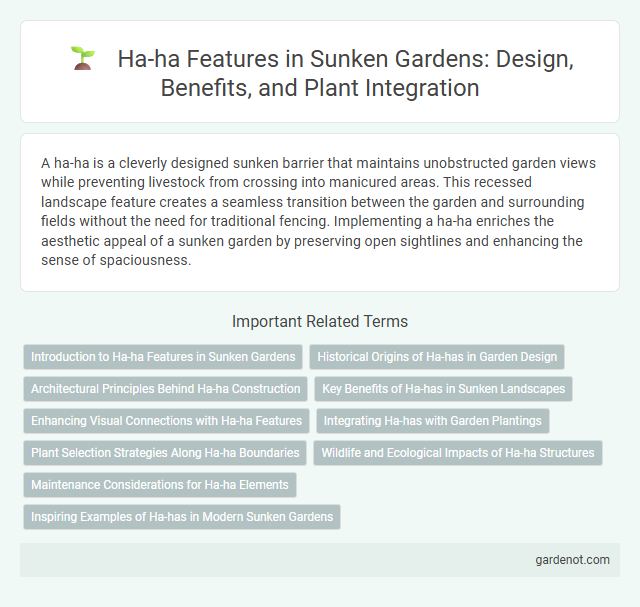A ha-ha is a cleverly designed sunken barrier that maintains unobstructed garden views while preventing livestock from crossing into manicured areas. This recessed landscape feature creates a seamless transition between the garden and surrounding fields without the need for traditional fencing. Implementing a ha-ha enriches the aesthetic appeal of a sunken garden by preserving open sightlines and enhancing the sense of spaciousness.
Introduction to Ha-ha Features in Sunken Gardens
The ha-ha in sunken gardens serves as a recessed landscape barrier that maintains unobstructed views while preventing livestock from entering the garden area. Characterized by a vertical retaining wall with a sloped embankment on the opposite side, this feature blends seamlessly into the natural terrain. Its design balances aesthetic appeal with practical functionality, preserving the garden's integrity without visible fencing.
Historical Origins of Ha-has in Garden Design
Ha-has originated in 18th-century English landscape gardens as a sunken fence design that preserved uninterrupted views while serving as a concealed boundary. This innovative feature eliminated the need for visible barriers, subtly protecting gardens from livestock without disrupting the natural aesthetics. The term "ha-ha" derives from the element of surprise visitors experienced upon encountering the hidden ditch, reflecting its clever integration in historic estate landscapes.
Architectural Principles Behind Ha-ha Construction
The ha-ha employs strategic earthworks and recessed stone walls to create an invisible barrier that preserves uninterrupted sightlines while preventing livestock from crossing into garden areas. Architectural principles emphasize blending functionality with aesthetics by integrating sunken trenches that maintain open views of the landscape. This design uses the natural slope to minimize structural disruption, enhancing both security and visual continuity in the sunken garden.
Key Benefits of Ha-has in Sunken Landscapes
Ha-has in sunken landscapes create unobstructed views by blending seamlessly with natural terrain, enhancing visual appeal while maintaining boundary security. They prevent livestock from crossing without disrupting the aesthetic flow of gardens, preserving both functionality and beauty. This subtle barrier also allows for safer walkways by defining spaces without the hazards of traditional fences or walls.
Enhancing Visual Connections with Ha-ha Features
Ha-ha features enhance visual connections by seamlessly integrating landscaped areas without obstructing sightlines, allowing uninterrupted views across garden spaces. These recessed walls or sunken fences act as invisible barriers that maintain open vistas while providing functional boundaries for safety and containment. Incorporating ha-ha elements in sunken gardens preserves the aesthetic flow and spatial continuity, reinforcing harmonious interactions between different garden sections.
Integrating Ha-has with Garden Plantings
Integrating ha-has with garden plantings enhances the seamless transition between formal garden spaces and surrounding landscapes by providing unobtrusive boundaries that maintain open sightlines. Strategic placement of mixed shrubs, perennials, and ground covers along the ha-ha complements its structural design while masking the ditch, creating a naturalistic aesthetic. This combination preserves the sunken garden's visual depth and tranquility, ensuring both functionality and beauty in the landscape architecture.
Plant Selection Strategies Along Ha-ha Boundaries
Plant selection along ha-ha boundaries prioritizes species with deep root systems to maintain soil integrity and prevent erosion. Native grasses, hardy shrubs, and drought-resistant perennials are favored for their resilience and low maintenance requirements. Strategic layering of groundcovers, mid-height plants, and taller shrubs creates visual interest while ensuring the ha-ha's structural functionality remains intact.
Wildlife and Ecological Impacts of Ha-ha Structures
Ha-ha structures in sunken gardens create unobtrusive barriers that maintain open sightlines while protecting wildlife habitats from human intrusion. Their design minimizes habitat fragmentation, allowing small mammals, birds, and insects to thrive undisturbed within garden ecosystems. By reducing soil erosion and preserving native vegetation, ha-ha walls contribute to sustaining biodiversity and enhancing ecological stability in managed landscapes.
Maintenance Considerations for Ha-ha Elements
Maintaining ha-ha elements in sunken gardens requires regular inspection to prevent soil erosion and structural damage to the retaining edges, ensuring clear visibility and safety. Vegetation control along the ha-ha prevents root intrusion that can destabilize the recessed walls, preserving the clean delineation between garden and lawn. Proper drainage systems must be checked frequently to avoid water accumulation, which can weaken the ha-ha's foundation and compromise its long-term durability.
Inspiring Examples of Ha-has in Modern Sunken Gardens
The Ha-ha, a recessed landscape design feature creating a vertical barrier without obstructing views, enhances modern sunken gardens by seamlessly blending indoor and outdoor spaces. Notable examples include the sunken garden at Kensington Palace, where the Ha-ha provides unobstructed sightlines while ensuring privacy and containment of wildlife. This technique maximizes visual openness and integrates natural elements, embodying innovative landscape architecture principles in contemporary garden design.
Ha-ha Infographic

 gardenot.com
gardenot.com